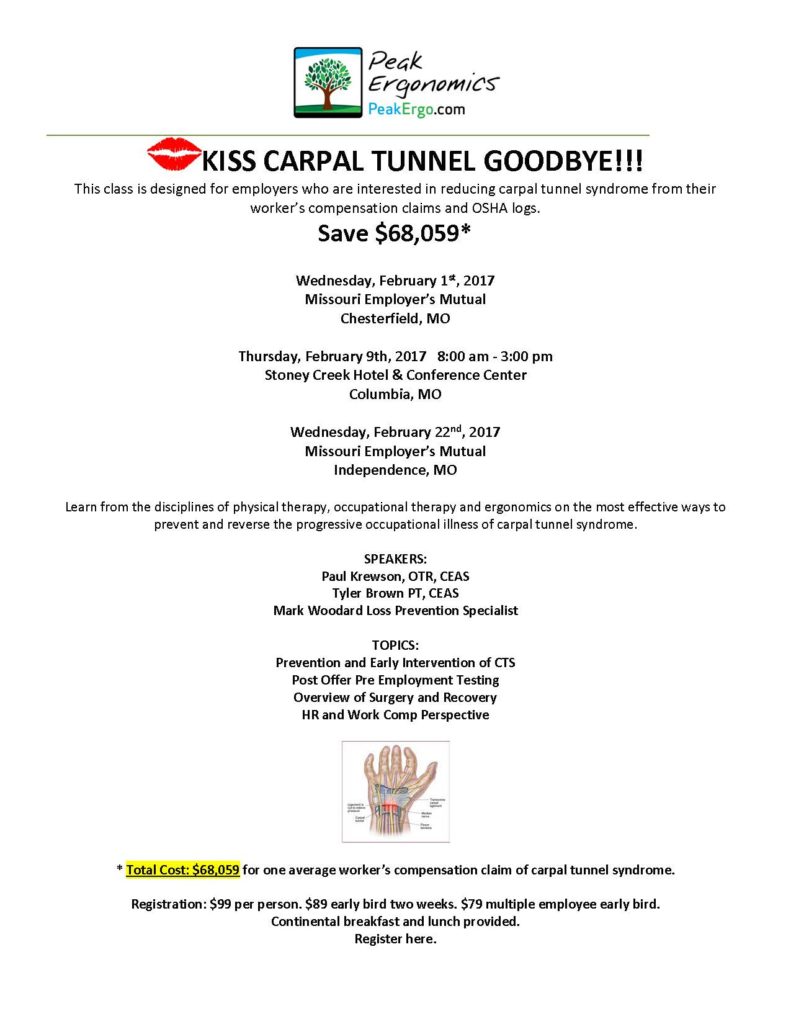
Past Seminar: “Kiss Carpal Tunnel Goodbye”
“Kiss Carpal Tunnel Goodbye” is designed for employers who are interested in reducing carpal tunnel syndrome from their worker’s compensation claims and OSHA logs.
Wednesday, February 1st, 2017
Missouri Employer’s Mutual Chesterfield, MO
Thursday, February 9th, 2017 8:00 am – 3:00 pm
Stoney Creek Hotel & Conference Center Columbia, MO
Wednesday, February 22nd, 2017
Missouri Employer’s Mutual Independence, MO
Learn from the disciplines of physical therapy, occupational therapy, and ergonomics on the most effective ways to prevent and reverse the progressive occupational illness of carpal tunnel syndrome.
SPEAKERS:
- Paul Krewson, OTR, CEAS
- Tyler Brown PT, CEAS
- Mark Woodard Loss Prevention Specialist
TOPICS:
- Prevention and Early Intervention of CTS
- Post Offer Pre Employment Testing
- Overview of Surgery and Recovery
- HR and Work Comp Perspective
Ways to Prevent/Reverse Carpal Tunnel Syndrome
- Ergonomic Workstations: One of the primary contributors to CTS is poor ergonomics. Ensure your workstation is properly set up with an ergonomic chair, keyboard, and mouse. Maintain a neutral wrist position to minimize stress on the median nerve, which is responsible for CTS symptoms.
- Frequent Breaks and Stretching: Incorporate short breaks into your workday to stretch your wrists and hands. Simple exercises like wrist flexor and extensor stretches can help relieve tension and improve blood circulation.
- Proper Typing Technique: Pay attention to your typing technique. Avoid excessive force on the keys and try to keep your wrists in a neutral position while typing. A split keyboard or an ergonomic keyboard can also help.
- Wrist Braces and Supports: Consider wearing wrist braces or supports, especially if you’ve experienced CTS symptoms. These aids can provide stability and reduce strain on the wrists during repetitive tasks.
- Anti-Inflammatory Diet: Nutrition plays a role in preventing inflammation that can contribute to CTS. Incorporate foods rich in Omega-3 fatty acids, such as salmon and walnuts, to reduce inflammation and support joint health.
- Maintain a Healthy Weight: Excess body weight can increase the risk of CTS. Maintain a healthy weight through a balanced diet and regular exercise to reduce pressure on your wrists.
- Proper Hand Posture: Be mindful of your hand posture during activities. Avoid excessive flexion or extension of the wrists and maintain a neutral position when using tools or performing tasks.
- Stress Management: Chronic stress can exacerbate CTS symptoms. Practice stress-reduction techniques such as deep breathing, meditation, or yoga to keep stress levels in check.
- Professional Evaluation: If you experience persistent symptoms of CTS, consult a healthcare professional or an ergonomics expert. Early diagnosis and intervention can prevent further damage.
Things to Remember
Prioritizing ergonomics, taking regular breaks, and adopting a healthy lifestyle are essential steps in maintaining wrist health. Remember, a proactive approach to workplace safety and ergonomics can go a long way in ensuring your well-being and productivity in the long run.
